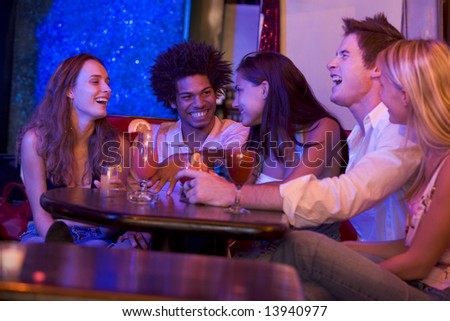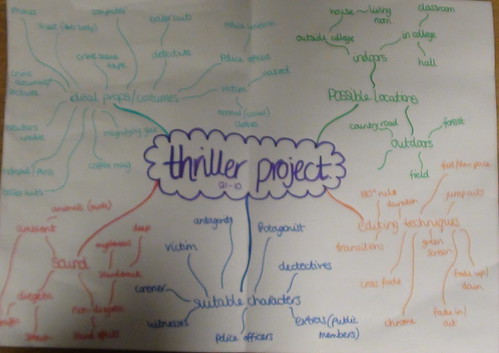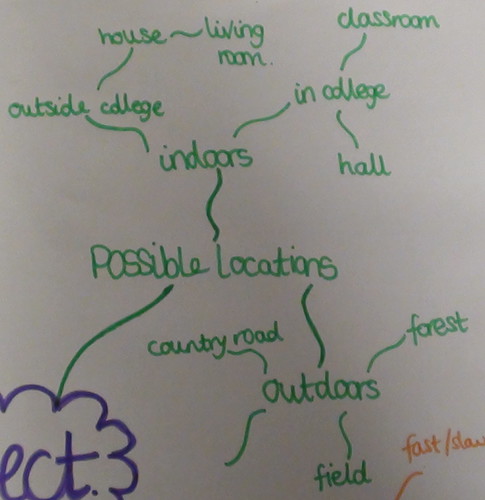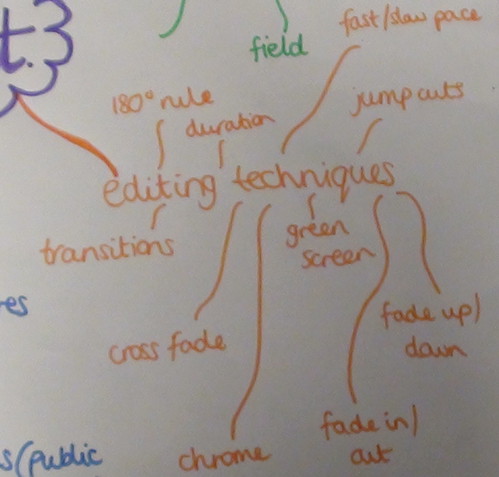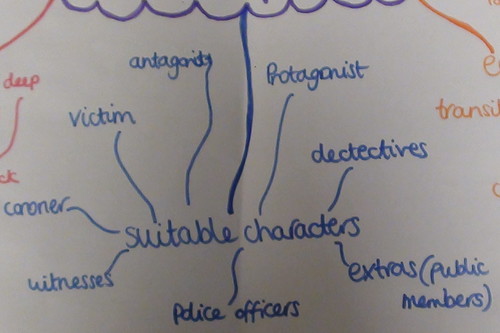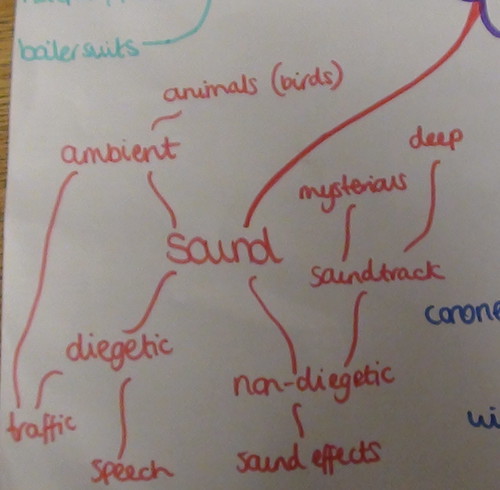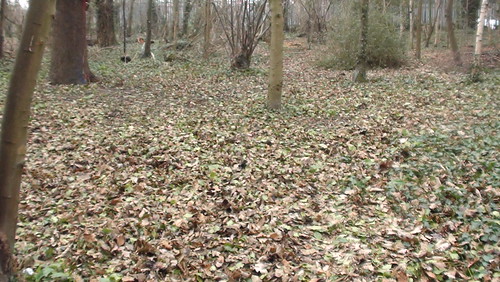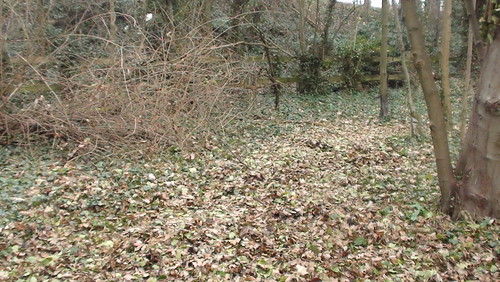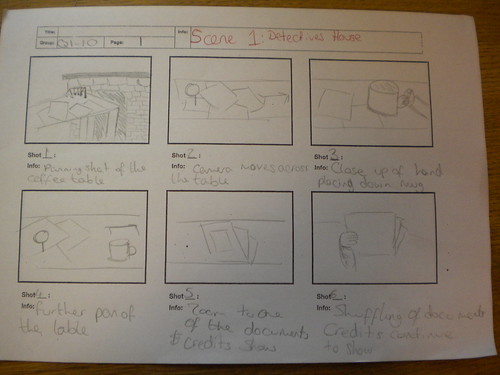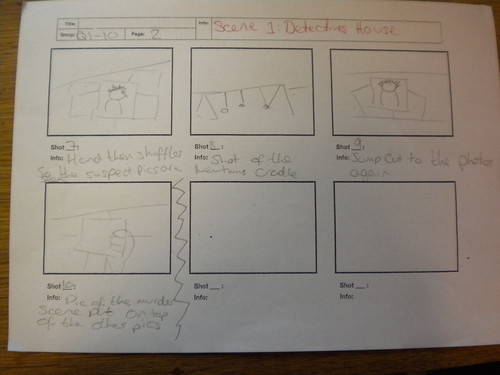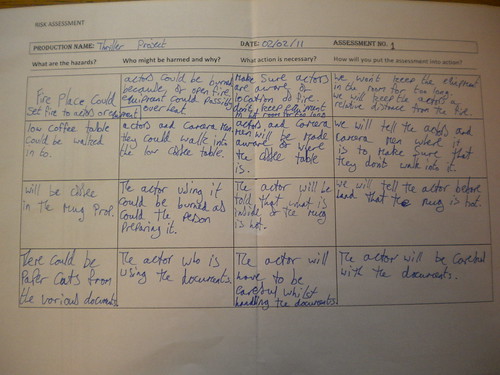For any film the title of the film is very important as this is what first captures the audiences attention to it therefore we need to take extra attention to it when we decide upon the title of our film.
As our thriller is within the sub genre of a crime thiller the title will need to protray this in some way so that the audience will know instantly what it is about.
After thinking of some ideas, we came up with a few suggestions;
The Killing
Resolution
The Curious Killings
The Case Of The Killer
We think that the most appropriate one for our project is 'Resolution' because it is catchy and fits well with the genre and our sequence. It will also give the audience a subtle idea of what they can expect to be included in our film.
Tuesday, 22 February 2011
Filming Roles
During filming we will each take on different roles in order to make sure our project is completed in a proffessional manner.
Actors
They will need to make sure their acting seems realistic and not forced. They will be under the control of the director.
In our project, we had to use extra people from outside of our group to allow our plans to work. Harriets brother Ollie Sim is the only actor in scene 1, and in scene 2, there are 3 actors (Sam Brown, Ed Selvey and Sam Pudney).
The Director
Is the person who is charge of over seeing the filming of the production and will have control of making key decisions about the production such as location, filming angles etc. However they will take advice from other member son set in order to make sure the film gets a high quality finish.
In our project, we are all directors in one way or another, although arguably, Harriet is the strongest (maybe due to the bossiness?!?), although her being out of the frame and acting as camera woman may have helped.
Camera Man/Woman
This is the person in charge of operating the camera, they will make sure the camera is steady, placed at the correct angle, and that it is safe and that no equipment is on set or at risk of being broken. They will also be able to advise the direcot on what angles and shots would be best alterntives to those already being used.
In our project, Harriet was the camera woman for scene 1, as she also was for scene 2.
Prop & Costume Manager
This person is in charge of making sure the characters and set looks realistic and that whatever is needed is on set at the appropriate times.
In our project, Harriet managed and kept control of these, although individuals were set to be responsible for different props and costumes.
Actors
They will need to make sure their acting seems realistic and not forced. They will be under the control of the director.
In our project, we had to use extra people from outside of our group to allow our plans to work. Harriets brother Ollie Sim is the only actor in scene 1, and in scene 2, there are 3 actors (Sam Brown, Ed Selvey and Sam Pudney).
The Director
Is the person who is charge of over seeing the filming of the production and will have control of making key decisions about the production such as location, filming angles etc. However they will take advice from other member son set in order to make sure the film gets a high quality finish.
In our project, we are all directors in one way or another, although arguably, Harriet is the strongest (maybe due to the bossiness?!?), although her being out of the frame and acting as camera woman may have helped.
Camera Man/Woman
This is the person in charge of operating the camera, they will make sure the camera is steady, placed at the correct angle, and that it is safe and that no equipment is on set or at risk of being broken. They will also be able to advise the direcot on what angles and shots would be best alterntives to those already being used.
In our project, Harriet was the camera woman for scene 1, as she also was for scene 2.
Prop & Costume Manager
This person is in charge of making sure the characters and set looks realistic and that whatever is needed is on set at the appropriate times.
In our project, Harriet managed and kept control of these, although individuals were set to be responsible for different props and costumes.
Editing Roles
Logo
We have already created the logo for our production (below). We could animate this in some way in the editing process however we can just use a fade in and fade out when it features in the title sequence.
We have already created the logo for our production (below). We could animate this in some way in the editing process however we can just use a fade in and fade out when it features in the title sequence.
Sound
Much of the sound for our production will come from ambient sounds within the detectives room and in the forest however as with the logo we do have the possibility of creating a form of soundtrack to add to the production during the editing process. This will be done using Garageband however the sound that is attached to the footage will be edited within Final Cut.
Video Editor
The role of the editor will be shared between the group, but this person will follow the storyboard and shot list in order to to put the footage in the correct order. They will also be responsible for adding the title sequence, transitions and any other effects that are necessary to complete the editing of the sequence. This will be done using Final Cut.
Equipment
It was important that we knew how to use the equipment needed to film before we started filming and what equipment we would be using.
The Cameras we used were a HD digital video camera which were easy to use and to transport where we needed them to be as they weren't bulky which was important for filming outside fo college as well as on college grounds. As if the camera was too big and bulky to take anywhere it would make filming alot harder. As the this project is the first time we will be using these cameras it was was important that we knew how to use them as we had a very limited time for filming so we couldn't make any mistakes that would lead to us needing to re-film any clips.
The tripod again was easy to use and easy to transport where we needed it to be which like the camera meant filming was a lot easier. As we used these for the Children's Film project we knew how to use them and there wasn't any major problems with using it.
However, we would have liked to have had experience with the dolly, especially as it would have helped in our filming for scene 1, but due to bad organisation we couldn't get hold of one. This was a shame as then we would have used all the equipment we had been offered, and been able to gain experience from them all.
The Cameras we used were a HD digital video camera which were easy to use and to transport where we needed them to be as they weren't bulky which was important for filming outside fo college as well as on college grounds. As if the camera was too big and bulky to take anywhere it would make filming alot harder. As the this project is the first time we will be using these cameras it was was important that we knew how to use them as we had a very limited time for filming so we couldn't make any mistakes that would lead to us needing to re-film any clips.
The tripod again was easy to use and easy to transport where we needed it to be which like the camera meant filming was a lot easier. As we used these for the Children's Film project we knew how to use them and there wasn't any major problems with using it.
However, we would have liked to have had experience with the dolly, especially as it would have helped in our filming for scene 1, but due to bad organisation we couldn't get hold of one. This was a shame as then we would have used all the equipment we had been offered, and been able to gain experience from them all.
Post Production
The following is a list of things that will be completed within the editing stage of our thriller production.
- Finalise the production logo so that it can be used within the sequence
- Sound effects/ Sound Track (make in garageband)
- Rough cut of the sequence - a basic cut of the sequence (make in Fanal Cut)
Friday, 18 February 2011
The Title Sequence- Colours
It'll be important that our title sequence has contrasting colours to the footage in order for it to stand and be legible.
Most of the title sequence will appear on a white background, so the titles will have to be dark colours, in quite dull shades. However this is good for us, as we are trying to convey the conventions of the thriller genre. Our most appropriate choices are:
Red
Blue
Black
We found out the 'meanings' of these colours, to help us decide which relates best to our project.
Red is the warmest colour of them all, and closely linked to the love and fortitude. Although it is also known to mean anger or temper, as well as danger and blood, survival and vitality.
Blue supposedly shows faith, immortality, eternity and spirituality. It is known to be one of the more calming colours, as it can be linked to heaven and the sky. However, the different shades of blue can give quite different meanings.
Black can be mistaken in different contexts to mean one of two things; either smart, posh elegant and formal, or, on the other hand, evil, grief, despair, threatening or even death.
We will be more likely to use black as this fits in at the time in which the titles appear; on a document, with black font on it. To make the titles stand out to this background fonts, we will have to make sure that the titles are bold and a lot larger than the other font on the documents within the mise-en-scene.
Most of the title sequence will appear on a white background, so the titles will have to be dark colours, in quite dull shades. However this is good for us, as we are trying to convey the conventions of the thriller genre. Our most appropriate choices are:
Red
Blue
Black
We found out the 'meanings' of these colours, to help us decide which relates best to our project.
Red is the warmest colour of them all, and closely linked to the love and fortitude. Although it is also known to mean anger or temper, as well as danger and blood, survival and vitality.
Blue supposedly shows faith, immortality, eternity and spirituality. It is known to be one of the more calming colours, as it can be linked to heaven and the sky. However, the different shades of blue can give quite different meanings.
Black can be mistaken in different contexts to mean one of two things; either smart, posh elegant and formal, or, on the other hand, evil, grief, despair, threatening or even death.
We will be more likely to use black as this fits in at the time in which the titles appear; on a document, with black font on it. To make the titles stand out to this background fonts, we will have to make sure that the titles are bold and a lot larger than the other font on the documents within the mise-en-scene.
The Title Sequence- Fonts
The font of the title sequence is very important within a film, therefore we want to choose one that fits into our genre and runs alongside our film well. We used dafont.com to help us come up with some ides, and choose the most appropriate one which we would include.
We all like this font as it is clear and would represent our genre well. On the other hand, it is quite bland and plain, and has no real character. Although it would be suitable, we don't feel that it is enough to make an impact on our credits and make it unique and stand out.
Although this was one of the fonts which stood out to us the most, we think that it gives the impression of a horror more than thriller, just like 'Beat My Guest', but this is portrayed in the more violent and bloody aspects. This would probably be our first choice if we were doing a film which included a murder, or one which included the gory and gruesome parts, but for our crime thriller it's not the most popular font.
This font is ideal for our project as it is both easy to read and fits well into our credit scene. We will use this as we believe that it is the best font available out of our choices. With our detective scene this is very effective, as it can easily be related with them and it can come across as 'serious'- perfect for a crime thriller.
We felt that this font made a big impression as it looks realistic. It would easily fit with our genre and the visuals during the credits scene, however it is very important for the audience to be able to read it easily, which this font makes it hard to do.
Mark Scheme
We feel that within the research and planning section, we are at a level 3 (12-15 marks).
The level 3 criteria for this section is that:
- There is proficient research into similar products and potential target audience.
- There is proficient organisation of actors, locations, costumers or props.
- There is proficient work on shotlists, layouts, drafting, scripting or storyboarding.
- There is a good level of care in the presentation of the research and planning.
- Time management is good.
We feel that we are at this level because we have done in-depth research into similar films and their opening sequences, looking into their codes and conventions, as well as everything that is important to us as a group, such as the titles and their colours and fonts. After doing this, we decided on our favourite thriller opening sequence (Se7en) and used it as inspiration. This has shown that we have done proficient research into similar products. As well as this, we looked into target audiences and certifications, and which would be the more appropriate for our project. We also developed this research further by including the interests and lifestyle of our potential audience.
Alongside this, we thought that our work on shotlists, drafting, scripting and storyboarding was done to a reasonably good standard.
Rounding these two points together, we have tried our best to ensure that the level of care in the presentation of the research and planning stages were up to an excellent level, by using appropriate images in the appropriate places and using different types of text where needed to give the people reading our blog to understand it easier and to be able to relate to it better.
The weakest points in this level of criteria for us was the organisation and the time management. Although these were not done to level 2, we feel that these points have stopped us getting to level 4.
The level 3 criteria for this section is that:
- There is proficient research into similar products and potential target audience.
- There is proficient organisation of actors, locations, costumers or props.
- There is proficient work on shotlists, layouts, drafting, scripting or storyboarding.
- There is a good level of care in the presentation of the research and planning.
- Time management is good.
We feel that we are at this level because we have done in-depth research into similar films and their opening sequences, looking into their codes and conventions, as well as everything that is important to us as a group, such as the titles and their colours and fonts. After doing this, we decided on our favourite thriller opening sequence (Se7en) and used it as inspiration. This has shown that we have done proficient research into similar products. As well as this, we looked into target audiences and certifications, and which would be the more appropriate for our project. We also developed this research further by including the interests and lifestyle of our potential audience.
Alongside this, we thought that our work on shotlists, drafting, scripting and storyboarding was done to a reasonably good standard.
Rounding these two points together, we have tried our best to ensure that the level of care in the presentation of the research and planning stages were up to an excellent level, by using appropriate images in the appropriate places and using different types of text where needed to give the people reading our blog to understand it easier and to be able to relate to it better.
The weakest points in this level of criteria for us was the organisation and the time management. Although these were not done to level 2, we feel that these points have stopped us getting to level 4.
Target Audience
People of all ages over 15 should enjoy our film, of all shapes, sizes, races and abilities, but we are primarily aiming our project at active, young-middle aged adults, who thrive for thrillers and gain adrenaline from fast-paced, surreal experiences. They will be interested in solving problems, and especially the 'crime' aspects of life. The ages of our target audience can be divided into two groups; 15-25 and 25-35, because they will have different interests. The younger catagory will be teenagers and young adults, who will enjoy things like going out clubbing, taking part in sports activities and shopping. They will aloso like trips to the cinema, either by themselves, or with family or friends. This applies to the older catagories of our target audience, too. However, they will enjoy the more relaxing activities as they may be settling down with a partner creating a family.

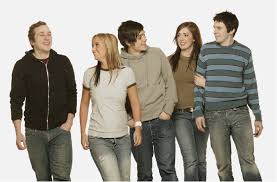



Our product would be enjoyed by our target audience mainly because of its genre. Because of our strong insperations from existing crime thrillers, we have aimed to make it similar to other professional thrillers like Se7en, as we know that films like this, and the ones we researched about, have been popular with 15-35 year olds. This is why we have aimed to produce our project similar to these, but with our own unique twist, to help us find an appropriate target audience and ensure that they will enjoy it and be pleased that they chose to watch it over the other several thrillers which will be shown at cinemas around the same time!



Our thriller project conforms to the 15 classification meaning that no-one under the age of 15 can view it, because it may be found inappropriate to these people. We feel that our target audience 15-35 allows both the appropriate teenagers and the older generation to enjoy our film. However, if anyone above the age of 35 wanted to watch it, there are no restrictions that they can not, we just feel that 25-35 year olds would enjoy it the most. Most students and university graduates enjoy the experience of watching thriller films, especially if they have the 'scary' and realistic aspects within it. The majority of 25-35 year olds are employed and may have children, so they might like to go out once in a while and see films at cinemas, which we feel would be an attractive film for them to view.
Our product would be enjoyed by our target audience mainly because of its genre. Because of our strong insperations from existing crime thrillers, we have aimed to make it similar to other professional thrillers like Se7en, as we know that films like this, and the ones we researched about, have been popular with 15-35 year olds. This is why we have aimed to produce our project similar to these, but with our own unique twist, to help us find an appropriate target audience and ensure that they will enjoy it and be pleased that they chose to watch it over the other several thrillers which will be shown at cinemas around the same time!
Classification
The (BBFC) British Board of Film Classification is an independant, non governmental body, that has been classifying cinema films since 1912, and has been setting guidelines for video work. The BBFC watches and classifys films and videoworks, making sure they stick to the quidelines which they have also set up as they feel some things may be unsuitable or inappropriate for certain age groups.
 'U' has to make sure it is suitable for age four and over. It has to be set with a positive moral, and ensure that all violence, threat or horror, is counterbalanced. Any discrimination or discriminative behavior is not allowed. No references to any drugs are allowed, and it must contain a anti-drug message towards to target audience. There should be mild scary scenes which are short and the outcome must be reassuring. No behaviour which children may be tempted to copy is permitted. There must be only occasional nudity, with no sexual contact,if any it should be very mild eg. kissing, holding hands, and if needed there should only be references to making love. Its essential that only very mild bad language is used.
'U' has to make sure it is suitable for age four and over. It has to be set with a positive moral, and ensure that all violence, threat or horror, is counterbalanced. Any discrimination or discriminative behavior is not allowed. No references to any drugs are allowed, and it must contain a anti-drug message towards to target audience. There should be mild scary scenes which are short and the outcome must be reassuring. No behaviour which children may be tempted to copy is permitted. There must be only occasional nudity, with no sexual contact,if any it should be very mild eg. kissing, holding hands, and if needed there should only be references to making love. Its essential that only very mild bad language is used.
 'PG' is known for being viewed but some scenes may be unsuitable for young children. A 'PG' should not discomfort or cause any disturbance to any children ages 8 or younger. Although parents are advised that if they feel that any of the content may be unsuitable for their child. Discriminative language or behaviour is extremely unlikely to be unacceptable unless its for an educational purposes. References to illegal drugs or drug misuse must also carry a positive message about anti-drugs. Scary or frightening scenes but be short and not intense. There must not be any potential bad behaviour that children may be likely to copy. There should only be mild bad language, and natural nudity, containing no sexual context, sexual contact may be implied making sure its only moderate, and infrequent. Must contain very moderate violence, without any detail, and no infliction on pain or injury.
'PG' is known for being viewed but some scenes may be unsuitable for young children. A 'PG' should not discomfort or cause any disturbance to any children ages 8 or younger. Although parents are advised that if they feel that any of the content may be unsuitable for their child. Discriminative language or behaviour is extremely unlikely to be unacceptable unless its for an educational purposes. References to illegal drugs or drug misuse must also carry a positive message about anti-drugs. Scary or frightening scenes but be short and not intense. There must not be any potential bad behaviour that children may be likely to copy. There should only be mild bad language, and natural nudity, containing no sexual context, sexual contact may be implied making sure its only moderate, and infrequent. Must contain very moderate violence, without any detail, and no infliction on pain or injury.
 '12A'/'12' is a category which is only been made for cinema films. No one younger then 12 is legally allowed to see a '12A' film unless accompanied by an adult. Both '12' and '12A' are classified with the same criteria, which in general is suitable for ages 12 and above. No child that is younger then 12 may but rent or watch a '12' rated video work. The Guidelines make sure that only moderate language is allowed, and any need of the use of strong language must be rarely used. Also any dicrimminative language or behaviour is not accepted unless it is clearly commended. There must also be infrequent misuse of drugs, and physical and psychological threat may be permitted as long as it is kept sustained. Sexual contact must be brief and dicsreet, and nudity is allowed. Sexual activity must be discreet and very briefly portayed within a scene. Sexual refrences must be mild and only what teenagersare suitable for. Only moderate violence allowed, with no real emphasis of, blood, and sexual violence.
'12A'/'12' is a category which is only been made for cinema films. No one younger then 12 is legally allowed to see a '12A' film unless accompanied by an adult. Both '12' and '12A' are classified with the same criteria, which in general is suitable for ages 12 and above. No child that is younger then 12 may but rent or watch a '12' rated video work. The Guidelines make sure that only moderate language is allowed, and any need of the use of strong language must be rarely used. Also any dicrimminative language or behaviour is not accepted unless it is clearly commended. There must also be infrequent misuse of drugs, and physical and psychological threat may be permitted as long as it is kept sustained. Sexual contact must be brief and dicsreet, and nudity is allowed. Sexual activity must be discreet and very briefly portayed within a scene. Sexual refrences must be mild and only what teenagersare suitable for. Only moderate violence allowed, with no real emphasis of, blood, and sexual violence.


'15' no one younger then 15 is allowed to watch, rent or buy a '15' rated video work. The video work must not contain any discrimminatory behaviour or language. Any dangerous behavioir should not have detail that may be copied, and can not endorse any behaviour such as, hanging, suicide, selfharming etc. Only frequent use of bad language, the occasional stronger language may only be allowed if justified by the context, and if repeated its not suitable for a '15'. Nudity is only allowed without any strong detail to sexual context, unless its educational purposes. Sexual activity is allowed to be shown without any real strong detail. Works where the purpose of sexual stimulation or arousal in generally unacceptable. No theme is endorsed unless is appropriate for 15 year olds. Violence should not dwell on the infliction of serious injury or pain, and the stonger images like gore are unlikely to be acceptable.
 '18' is only suitable for adults and no one younger than 18 is allowed to see a '18' in a cinema, and they are not allowed to rent or buy any 18' rated video works. Due to the Human Rights Acts 1998 at age 18, the BBFCs quidelines state that adults are free to have thier own opinion on the entertainment they view, althought the BBFC feels that the guideline concerns shouldnt normally override the principle. Exceptions are allowed like, sexual activity images may be allowed, and containing images of real sex, sexual explicit images, and very stong sexual images must be made to 'R18' the content thats unsuitable for 'R18' is also unacceptable for '18'.
'18' is only suitable for adults and no one younger than 18 is allowed to see a '18' in a cinema, and they are not allowed to rent or buy any 18' rated video works. Due to the Human Rights Acts 1998 at age 18, the BBFCs quidelines state that adults are free to have thier own opinion on the entertainment they view, althought the BBFC feels that the guideline concerns shouldnt normally override the principle. Exceptions are allowed like, sexual activity images may be allowed, and containing images of real sex, sexual explicit images, and very stong sexual images must be made to 'R18' the content thats unsuitable for 'R18' is also unacceptable for '18'.
 'R18' is a special classification mainly because they are only shown to adults in specially licensed cinemas, or supplied in licensed sex shops. No material which is in breach of the law is allowed, and any sexual activity which can encourage abusive sexual behaviour is to be endorsed. Which could incluse adults role-playing as not being adults, also any sexual activity which involves having no consent is not allowed, and any infliction of pain or phyical harm, is forbidden.
'R18' is a special classification mainly because they are only shown to adults in specially licensed cinemas, or supplied in licensed sex shops. No material which is in breach of the law is allowed, and any sexual activity which can encourage abusive sexual behaviour is to be endorsed. Which could incluse adults role-playing as not being adults, also any sexual activity which involves having no consent is not allowed, and any infliction of pain or phyical harm, is forbidden.
These guidelines apply for trailers and advertisements, too. There must not be any adverts or trailers shown in a viewing which aren't suitable for the movie being shown. Although the content in the trailer is suitable for the classified film, it will encourage the audience to watch it (the trailer's purpose), however they will not be able to see it. This is unprofessional.
From looking at these guidelines, we are going to classify our thriller project as a 15 because violence will be roughly used, and strong language will occur in parts. Nudity will be used to a low level, but overall themes have forced us to lift our cerdificate to a 15. If we included the slightest more violence or nudity, it would be pushed to an 18, but we feel that this is not the case.

 'U' has to make sure it is suitable for age four and over. It has to be set with a positive moral, and ensure that all violence, threat or horror, is counterbalanced. Any discrimination or discriminative behavior is not allowed. No references to any drugs are allowed, and it must contain a anti-drug message towards to target audience. There should be mild scary scenes which are short and the outcome must be reassuring. No behaviour which children may be tempted to copy is permitted. There must be only occasional nudity, with no sexual contact,if any it should be very mild eg. kissing, holding hands, and if needed there should only be references to making love. Its essential that only very mild bad language is used.
'U' has to make sure it is suitable for age four and over. It has to be set with a positive moral, and ensure that all violence, threat or horror, is counterbalanced. Any discrimination or discriminative behavior is not allowed. No references to any drugs are allowed, and it must contain a anti-drug message towards to target audience. There should be mild scary scenes which are short and the outcome must be reassuring. No behaviour which children may be tempted to copy is permitted. There must be only occasional nudity, with no sexual contact,if any it should be very mild eg. kissing, holding hands, and if needed there should only be references to making love. Its essential that only very mild bad language is used. 'PG' is known for being viewed but some scenes may be unsuitable for young children. A 'PG' should not discomfort or cause any disturbance to any children ages 8 or younger. Although parents are advised that if they feel that any of the content may be unsuitable for their child. Discriminative language or behaviour is extremely unlikely to be unacceptable unless its for an educational purposes. References to illegal drugs or drug misuse must also carry a positive message about anti-drugs. Scary or frightening scenes but be short and not intense. There must not be any potential bad behaviour that children may be likely to copy. There should only be mild bad language, and natural nudity, containing no sexual context, sexual contact may be implied making sure its only moderate, and infrequent. Must contain very moderate violence, without any detail, and no infliction on pain or injury.
'PG' is known for being viewed but some scenes may be unsuitable for young children. A 'PG' should not discomfort or cause any disturbance to any children ages 8 or younger. Although parents are advised that if they feel that any of the content may be unsuitable for their child. Discriminative language or behaviour is extremely unlikely to be unacceptable unless its for an educational purposes. References to illegal drugs or drug misuse must also carry a positive message about anti-drugs. Scary or frightening scenes but be short and not intense. There must not be any potential bad behaviour that children may be likely to copy. There should only be mild bad language, and natural nudity, containing no sexual context, sexual contact may be implied making sure its only moderate, and infrequent. Must contain very moderate violence, without any detail, and no infliction on pain or injury.  '12A'/'12' is a category which is only been made for cinema films. No one younger then 12 is legally allowed to see a '12A' film unless accompanied by an adult. Both '12' and '12A' are classified with the same criteria, which in general is suitable for ages 12 and above. No child that is younger then 12 may but rent or watch a '12' rated video work. The Guidelines make sure that only moderate language is allowed, and any need of the use of strong language must be rarely used. Also any dicrimminative language or behaviour is not accepted unless it is clearly commended. There must also be infrequent misuse of drugs, and physical and psychological threat may be permitted as long as it is kept sustained. Sexual contact must be brief and dicsreet, and nudity is allowed. Sexual activity must be discreet and very briefly portayed within a scene. Sexual refrences must be mild and only what teenagersare suitable for. Only moderate violence allowed, with no real emphasis of, blood, and sexual violence.
'12A'/'12' is a category which is only been made for cinema films. No one younger then 12 is legally allowed to see a '12A' film unless accompanied by an adult. Both '12' and '12A' are classified with the same criteria, which in general is suitable for ages 12 and above. No child that is younger then 12 may but rent or watch a '12' rated video work. The Guidelines make sure that only moderate language is allowed, and any need of the use of strong language must be rarely used. Also any dicrimminative language or behaviour is not accepted unless it is clearly commended. There must also be infrequent misuse of drugs, and physical and psychological threat may be permitted as long as it is kept sustained. Sexual contact must be brief and dicsreet, and nudity is allowed. Sexual activity must be discreet and very briefly portayed within a scene. Sexual refrences must be mild and only what teenagersare suitable for. Only moderate violence allowed, with no real emphasis of, blood, and sexual violence. 

'15' no one younger then 15 is allowed to watch, rent or buy a '15' rated video work. The video work must not contain any discrimminatory behaviour or language. Any dangerous behavioir should not have detail that may be copied, and can not endorse any behaviour such as, hanging, suicide, selfharming etc. Only frequent use of bad language, the occasional stronger language may only be allowed if justified by the context, and if repeated its not suitable for a '15'. Nudity is only allowed without any strong detail to sexual context, unless its educational purposes. Sexual activity is allowed to be shown without any real strong detail. Works where the purpose of sexual stimulation or arousal in generally unacceptable. No theme is endorsed unless is appropriate for 15 year olds. Violence should not dwell on the infliction of serious injury or pain, and the stonger images like gore are unlikely to be acceptable.
 '18' is only suitable for adults and no one younger than 18 is allowed to see a '18' in a cinema, and they are not allowed to rent or buy any 18' rated video works. Due to the Human Rights Acts 1998 at age 18, the BBFCs quidelines state that adults are free to have thier own opinion on the entertainment they view, althought the BBFC feels that the guideline concerns shouldnt normally override the principle. Exceptions are allowed like, sexual activity images may be allowed, and containing images of real sex, sexual explicit images, and very stong sexual images must be made to 'R18' the content thats unsuitable for 'R18' is also unacceptable for '18'.
'18' is only suitable for adults and no one younger than 18 is allowed to see a '18' in a cinema, and they are not allowed to rent or buy any 18' rated video works. Due to the Human Rights Acts 1998 at age 18, the BBFCs quidelines state that adults are free to have thier own opinion on the entertainment they view, althought the BBFC feels that the guideline concerns shouldnt normally override the principle. Exceptions are allowed like, sexual activity images may be allowed, and containing images of real sex, sexual explicit images, and very stong sexual images must be made to 'R18' the content thats unsuitable for 'R18' is also unacceptable for '18'. 'R18' is a special classification mainly because they are only shown to adults in specially licensed cinemas, or supplied in licensed sex shops. No material which is in breach of the law is allowed, and any sexual activity which can encourage abusive sexual behaviour is to be endorsed. Which could incluse adults role-playing as not being adults, also any sexual activity which involves having no consent is not allowed, and any infliction of pain or phyical harm, is forbidden.
'R18' is a special classification mainly because they are only shown to adults in specially licensed cinemas, or supplied in licensed sex shops. No material which is in breach of the law is allowed, and any sexual activity which can encourage abusive sexual behaviour is to be endorsed. Which could incluse adults role-playing as not being adults, also any sexual activity which involves having no consent is not allowed, and any infliction of pain or phyical harm, is forbidden.These guidelines apply for trailers and advertisements, too. There must not be any adverts or trailers shown in a viewing which aren't suitable for the movie being shown. Although the content in the trailer is suitable for the classified film, it will encourage the audience to watch it (the trailer's purpose), however they will not be able to see it. This is unprofessional.
From looking at these guidelines, we are going to classify our thriller project as a 15 because violence will be roughly used, and strong language will occur in parts. Nudity will be used to a low level, but overall themes have forced us to lift our cerdificate to a 15. If we included the slightest more violence or nudity, it would be pushed to an 18, but we feel that this is not the case.

Thriller Music
The music within a thriller film is usually dark and constant, with a big build-up of instruments and various stings in the music, where appropriate with the visuals. This is used to help build up tension and makes the audience think something bad is going to happen because of the ominous tones. Although the sound is usually conjoined with what is happening within the mise-en-scene, there are occasions where the music seems irrelevant. Crescendo's are used a lot in thrillers, to make the audience jump and feel uneasy, especially at awkward times in the film.
Music within a thriller films is usually quite distintive. The film makers generally tend to use the music to create suspense and add tension to the scene this is usually done by having a fast drum beat as this makes the audience think something bad will happen (like in Jaws). The music that is used also generally fits with what is playing on screen as it is a very useful tool to 'play' with the audiences emotions.
Music within a thriller films is usually quite distintive. The film makers generally tend to use the music to create suspense and add tension to the scene this is usually done by having a fast drum beat as this makes the audience think something bad will happen (like in Jaws). The music that is used also generally fits with what is playing on screen as it is a very useful tool to 'play' with the audiences emotions.
Thursday, 17 February 2011
Thursday 17th February
Today we did the last few bits of our filming (scene 2), and made sure that all our clips were captured and saved on Final Cut. We also reviewed our blog and gave each other tasks to complete and hopefully extend our grade over half term.
Half Term Tasks
classification- every classification and our classification.
target audience- who our project is aimed at.
mark scheme- what level we think we're at.
title sequence- fonts and colours (with meaning).
target audience- who our project is aimed at.
mark scheme- what level we think we're at.
title sequence- fonts and colours (with meaning).
Filming Evaluation
Scene 1 was filmed on the evening of Saturday the 12th of February by Harriet at her house. Harriet was the camera-man, and her brother the 'unknown' actor. The shooting schedule was used and appeared to be a help, although changes were made which slightly changed the schedule. The props that we used really created the atmosphere that we were hoping for, and the lighting was how we were expecting it to be, although during the rehearsal shot, we realised that shadows were going to be needing more attention, so it would disrupt the piece as little as possible, although some were unavoidable. On the other hand, these shadows added to the anticipated atmosphere. We were also unfortunate to not be able to get hold of a dolly for the opening tracking shot, which would have made it more professional. We tried to overcome this problem by using a office chair (on wheels), but the camera was too low and the shots still came out wobbly, so in the end we were forced to do it hand-held. If we were to film this scene again, that would be a problem that would easily be able to be avoided, and we would have thought about it in more advance. Another problem which we had to adapt to, was that we hadn't got a picture of scene 2 which was going to allow the transition between the two scenes. This was due to bad organisation within the group and which we should have not had a problem with. But it happened, and Harriet filmed as much as she could have, with varieties of endings, as we will have to change our plans about this part of the project in the editing stage, and with many varieties we will have a range of ideas to choose from. Lastly, we thought that the filming would have looked better in one continuous shot, rather than several short ones joined with transitions, which wasn't seen in the shooting schedule. This is where the schedule proved to be unhelpful, and it also proved hard for both the camera-man and the actor to keep focus for such a long period of time, and doing everything as planned in order. This is why we had filmed many shots before we got one sequence that had actually worked, which, if the actor was a group member would have saved a lot of time and effort. However, the final product was close to what we were expecting, and came out surprisingly well for the problems we encountered.
Scene 2 was filmed over two days; Monday the 14th and Thursday the 17th of February, during the daytime in lesson. This was convenient for us as our location for this scene was on the college site, so we didn't have any troubles with transport. However, on the Thursday we came across another group which was recording around the same area as us. Both of the groups worked together to give each other time to film without the other group disturbing them. It was also useful for us as we were missing a character, so one of them kindly stepped in to help us film. The natural light between these two days were slightly different, as were the characters hair(!) which we didn't think about before! This would have affected continuity, but we decided to re-record the filming we did on Monday, again on Thursday, and this went smoothly as we already knew what to film, and how to go about doing this. Another problem we had was the unwanted ambient sound which we picked up. Filming right next to a railway track and a main road meant that we had to try our best to time the shots, at the best possible times. Also, although the rustling of the leaves gave a good effect, it meant that we could hear the cameraman moving which is really unprofessional. However, this was unavoidable and we will have to change this during the editing stage, perhaps by using a soundover. We managed to record background sound if this is the case. Overall, this scene didn't go as well as the first scene, but we managed to get it all filmed and hopefully the editing will allow us to improve it.
Scene 2 was filmed over two days; Monday the 14th and Thursday the 17th of February, during the daytime in lesson. This was convenient for us as our location for this scene was on the college site, so we didn't have any troubles with transport. However, on the Thursday we came across another group which was recording around the same area as us. Both of the groups worked together to give each other time to film without the other group disturbing them. It was also useful for us as we were missing a character, so one of them kindly stepped in to help us film. The natural light between these two days were slightly different, as were the characters hair(!) which we didn't think about before! This would have affected continuity, but we decided to re-record the filming we did on Monday, again on Thursday, and this went smoothly as we already knew what to film, and how to go about doing this. Another problem we had was the unwanted ambient sound which we picked up. Filming right next to a railway track and a main road meant that we had to try our best to time the shots, at the best possible times. Also, although the rustling of the leaves gave a good effect, it meant that we could hear the cameraman moving which is really unprofessional. However, this was unavoidable and we will have to change this during the editing stage, perhaps by using a soundover. We managed to record background sound if this is the case. Overall, this scene didn't go as well as the first scene, but we managed to get it all filmed and hopefully the editing will allow us to improve it.
Shot List
We had already done this and followed it when filming our project but seem to have misplaced it after! From our first ideas, our final product was very different, though.
Wednesday, 16 February 2011
Title Sequence Fonts & Colours
Se7en
As we took inspiration for our thriller from Se7en we decided that we would also take inspiration for the fonts and colours of our titles. Se7en uses a white coloured font to distinguish the text from the background which is dark, so in contrast, since our thriller has a light background we decided to use a darker font colour. This will allow the font colour to be seen on the lighter background. Se7en also uses a font that looks like a childs handwriting this gives the feeling of vulnerability. We will use a typewriter font to give the same effect but in our own way, which is necessary as our project is based on mature detectives (typical to use typewriters and computers).
Wednesday 16th February
We sorted through the clips of the first scene that were filmed over the weekend by Harriet. We renamed them according to what they were and deleted any clips that would be unusable. As well as doing this we also sorted through the filming we did on Monday.
Monday, 14 February 2011
Monday 14th February
We filmed a large part of our work, which meant that we could upload it and sort out the clips we wanted to use, and the ones we perhaps didnt want to film. We will finish filming on Wednesday and Thursday.
Thursday, 10 February 2011
Project Planning
Mind Map
This will be a visual presentation of all our ideas for our thriller project, and will allow us to form and explore our ideas so that we end up with the best possible sequence.
Storyboard
The storyboard needs to how the main shots in drawings. These are also accompanied by a description of what will be included in the shot. This is very important when planning a film as it shows and describes all of the shots, in the correct order. This then allows everyone involved in the making to know what happens, and when.
Location Recce
For the location recce to be beneficial to us we need to take photographs of the specific location to help us discover any potential problems that could occur in advance, so that we are able to take action to minimize the chances of these happening. We could use Google earth to do this, and get a birds-eye overview of the location, and where abouts it is situated in comparison to main and important places (eg. the nearest toilet). Alongside this, we need to make notes for the locations and find further information about it to discover how the scene looks and is at different parts during the day, that could disrupt our project (eg. the public, lighting)This will be a visual presentation of all our ideas for our thriller project, and will allow us to form and explore our ideas so that we end up with the best possible sequence.
Storyboard
The storyboard needs to how the main shots in drawings. These are also accompanied by a description of what will be included in the shot. This is very important when planning a film as it shows and describes all of the shots, in the correct order. This then allows everyone involved in the making to know what happens, and when.
Location Recce
Mise-en-scene List
This will help us gather all our props before hand, to minimize the time wasted and make the filming process flow more smoothly.
Shot List
A shot list is important as it includes all of the different shots we will be using or maybe using. It also helps us to be organised as it tells us what needs to be filmed. The shot list needs to be detailed and cover most aspects of our script.Shooting Schedule
The shooting schedule makes us aware of any restrictions we have to work with such as location and work. It will also enable us to know when and what we are filming, and in what order. By producing this it will mean we are able to see how long it should potentially take.
Script
This runs parallel to the storyboard, and is extremely important, as we will need it to know what happens, and at what point, along with any emotions or dialogue which needs to be taken into account before the start of the filming stage. This is quite likely to change from the original, but the core stays the same and gives the whole crew a stable image of the project as a whole, making the later stages easier.
Risk Assessment
A risk assessment is vital when filming a project. It covers every danger and hazard which will occur during our filming. This allows us to be aware of the dangers, and how we can avoid them.
Checklist 10/02/10
Thursday:
- do location recce for scene 1 (Harriet)
Friday:
- bring camera (Harriet)
- bring sheet (Stacey)
- do location recce for scene 2 (includes taking picture for scene 1) (all)
Over weekend:
- buy crime scene tape (Sam)
- buy boiler suits (Ed)
- produce documents (Stacey & Harriet)
- take pictures of suspects (Harriet)
- do digital storyboard for scene 1 (Harriet)
- film scene 1 (Harriet)
Monday:
- bring camera (Harriet)
- bring crime scene tape (Sam)
- bring sheet (Stacey)
- bring boiler suits (Ed)
- bring small notepad and pen (Harriet)
- do digital storyboard for scene 2 (all)
- film scene 2 (all)
Wednesday:
- continue filming scene 2 from Monday (all)
Thursday:
- continue filming scene 2 from Wednesday (all)
- do location recce for scene 1 (Harriet)
Friday:
- bring camera (Harriet)
- bring sheet (Stacey)
- do location recce for scene 2 (includes taking picture for scene 1) (all)
Over weekend:
- buy crime scene tape (Sam)
- buy boiler suits (Ed)
- produce documents (Stacey & Harriet)
- take pictures of suspects (Harriet)
- do digital storyboard for scene 1 (Harriet)
- film scene 1 (Harriet)
Monday:
- bring camera (Harriet)
- bring crime scene tape (Sam)
- bring sheet (Stacey)
- bring boiler suits (Ed)
- bring small notepad and pen (Harriet)
- do digital storyboard for scene 2 (all)
- film scene 2 (all)
Wednesday:
- continue filming scene 2 from Monday (all)
Thursday:
- continue filming scene 2 from Wednesday (all)
Wednesday, 9 February 2011
Shooting Schedule
Saturday 12th February 2011 (Scene 1)
Sunrise : 7:21 GMT Sunset : 17:04 GMT
17:00 - Go to LOCATION 1: Harriets living room. Set up scene. Get all props and position them correctly.
18:00 - Collect camera and equipment.
18:05 - Light fire.
18:10 - Film shot 1.
18:20 - Film shot 2.
18:50 - Film shot 3.
19:10 - Film shot 4.
19:35 - Film shot 5.
19:50 - Film shot 6.
20:00 - Film shot 7.
20:10 - Film shot 8.
Monday14th February 2011 (Scene 2)
Sunrise : 7:21 GMT Sunset : 17:04 GMT
13:15 - Go to LOCATION 2: The forest. Get all props and position them correctly.
13:20 - Set up props and actors.
13:30 - Film shot 9.
13:35 - Film shot 10.
13:50 - Film shot 11.
14:05 -Film shot 12.
Sunrise : 7:21 GMT Sunset : 17:04 GMT
17:00 - Go to LOCATION 1: Harriets living room. Set up scene. Get all props and position them correctly.
18:00 - Collect camera and equipment.
18:05 - Light fire.
18:10 - Film shot 1.
18:20 - Film shot 2.
18:50 - Film shot 3.
19:10 - Film shot 4.
19:35 - Film shot 5.
19:50 - Film shot 6.
20:00 - Film shot 7.
20:10 - Film shot 8.
Monday14th February 2011 (Scene 2)
Sunrise : 7:21 GMT Sunset : 17:04 GMT
13:15 - Go to LOCATION 2: The forest. Get all props and position them correctly.
13:20 - Set up props and actors.
13:30 - Film shot 9.
13:35 - Film shot 10.
13:50 - Film shot 11.
14:05 -Film shot 12.
Wednesday, 2 February 2011
Mise En Scene
Scene 1:
The location of our project in the first scene is going to be an indoor room which will have low lighting to create a dark atmosphere to present a uncomfortable and mysterious environment to the audience. the main source of light will be an open fire in a fireplace, which will add a sense of mystery and uncomfort as not the whole room is well lit and shown clearly to the audience.
The main focus of the scene is a coffee table on which there will be a load of evidence-like documents to convey to the audience the character in the scene that we don't see in full but see shadows of. there are also other objects on the table to support this character representation, like a phone, newtons cradle, empty coffee mug.
Scene 2:
The location of the second scene is in a forest to create a mysterious feeling. There will be crime scene tape around the trees to make it clear that the area is a crime scene. The scene will open with a flash of a camera so we need to have a camera.
We will have the body underneath a white sheet. Also, the detectives will wear a boilersuit costume or something similar, as well as a small note pad and a pen.
The location of our project in the first scene is going to be an indoor room which will have low lighting to create a dark atmosphere to present a uncomfortable and mysterious environment to the audience. the main source of light will be an open fire in a fireplace, which will add a sense of mystery and uncomfort as not the whole room is well lit and shown clearly to the audience.
The main focus of the scene is a coffee table on which there will be a load of evidence-like documents to convey to the audience the character in the scene that we don't see in full but see shadows of. there are also other objects on the table to support this character representation, like a phone, newtons cradle, empty coffee mug.
Scene 2:
The location of the second scene is in a forest to create a mysterious feeling. There will be crime scene tape around the trees to make it clear that the area is a crime scene. The scene will open with a flash of a camera so we need to have a camera.
We will have the body underneath a white sheet. Also, the detectives will wear a boilersuit costume or something similar, as well as a small note pad and a pen.
Subscribe to:
Posts (Atom)









